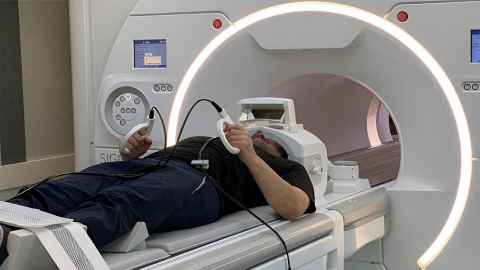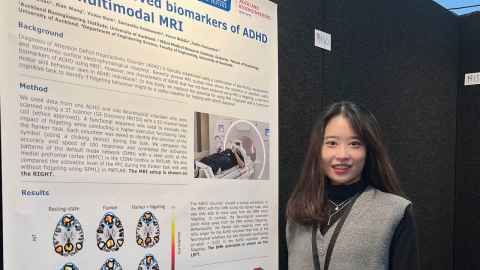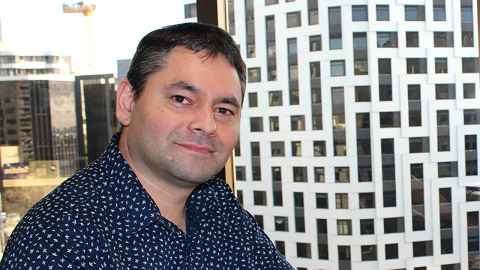Biting nails, tapping fingers, and twirling hair
28 July 2025
ADHD diagnosis still relies on checklists. Researchers want to change that, and brain scans of people fidgeting could be the key.

For the hundreds of thousands of Kiwis who live with attention deficit hyperactivity disorder (ADHD), fidgeting is often second nature.
Clicking a pen or fiddling with jewellery might seem like disruptive or distracting behaviours. Not so – at least if the person doing the fiddling or the clicking has ADHD. Research from the Auckland Bioengineering Institute at the University of Auckland, in partnership with the Mātai Medical Research Institute in Tairāwhiti Gisborne, suggests fidgeting could play an important, misunderstood – and essentially beneficial – role for those with the neurodevelopmental condition.
And they hope what they learn from scanning the ADHD brain in action, particularly when it’s involved in fidgeting behaviour, could help improve diagnosis of the condition.
Touching an estimated 280,000 people in Aotearoa – or roughly one in 20 New Zealanders – ADHD is a condition defined by a distinctly different brain structure, function and development.
Areas of the brain in someone with ADHD may mature more slowly, or have different activity levels than a neurotypical brain. This is particularly noticeable in the frontal lobe, the region responsible for executive functions like filtering and controlling attention, behaviour and judgement, and the ability to plan and organise.
Everyday tasks that come naturally to others can be hard to manage for someone with ADHD.
Still, despite its prevalence, there is a lot scientists and doctors don’t understand about ADHD, including what causes and drives these different brain functions, and how to accurately diagnose the condition.

For Xirui Zhao, a research assistant at the Auckland Bioengineering Institute, such questions were the catalyst for her recently finished PhD.
“I’ve always been drawn to research that bridges neuroscience, clinical work, and technology – and ADHD felt like a really important field where those worlds overlap,” she says.
“What stood out to me about ADHD is that, despite being so common, we still don’t fully understand the clinical presentations behind it.”
In particular, Zhao was curious that diagnosing ADHD still often relies upon behavioural checklists, even though these can be subjective and vary from person to person.
“So I started thinking, what if we could find more objective, brain-based biomarkers, that could support diagnosis and help us understand the condition better.”
In neuroscience, brain biomarkers – sometimes genes, molecules or special patterns observable in brain scans – offer clues that allow scientists to identify or track neurological conditions.
Before she began her PhD studies in 2021, Zhao had already been introduced to the world of biomarkers and brain magnetic resonance imaging (MRI), through her undergraduate studies with supervisor Professor Justin Fernandez.

Fernandez is a principal investigator in ABI’s musculoskeletal modelling group, but also has a strong interest in ADHD research. At the time Zhao was thinking about PhD study, Fernandez was working on a pilot study with Mātai Medical Research Institute researchers using MRI to investigate fidgeting and ADHD.
Fernandez says the link between the two was already well publicised – notably with controversy around “fidget spinners” popping up in classrooms.
“We started to wonder if there was a reason why people with ADHD presented different motor skills; we wondered if people were fidgeting with a purpose. Measuring people’s functional brain response while fidgeting in the MRI appeared the perfect way to prove this.”
The study showed fidgeting could improve activation of the decision-making region of the brain in people with ADHD, but the opposite was the case in neurotypical people.
With Zhao joining the group, the team combined a range of scans measuring brain shape, structure, function and chemical signature, to create a “multimodal atlas” of the ADHD brain.
Their hope is clinicians may be able to use this atlas – mapping a patient’s brain onto it to see how they compare.
“Given ADHD has different presentations and is on a spectrum, the atlas might reveal how the ADHD brain might depart from some neurotypical presentations,” Fernandez says.
“This, combined with a clinician’s expertise, could help the diagnosis process.”
I’m hoping it brings us even closer to building tools that can support more personalised and better understanding of ADHD.
Zhao says brain biomarkers might even help identify ADHD sub-types.
“We’re also seeing interesting differences across age and biological sex, which could have implications for more personalised approaches to diagnosis and treatment.
“The emerging theme is about using imaging and modelling to better understand the diversity within ADHD, not just between ADHD and neurotypical groups.”
Right now, the researchers are fine-tuning their protocol with advanced MRI sequences, enabling them to track changes in brain activity over short time periods, Zhao says.
“We want to capture more of the moment-to-moment variability that’s often seen in ADHD, which could give us deeper insight into how attention is regulated in real time.”
They are also drawing on artificial intelligence models to see if more brain biomarkers can be teased out from the data, and plan to run more tests on larger and more diverse groups of patients.
“It’s an exciting next step,” Zhao says, “and I’m hoping it brings us even closer to building tools that can support more personalised and better understanding of ADHD”.

Auckland Bioengineering Institute director Professor Merryn Tawhai says the ADHD work is a testament to the power of interdisciplinary research.
"By combining advanced imaging, engineering, and clinical insight, they’re beginning to uncover the neurological signatures behind behaviours like fidgeting – behaviours that have long been misunderstood.
"This is an important step toward a more compassionate and personalised approach to ADHD treatment."
Article written by Jamie Morton
Media contact
Nikki Mandow | Research communications
M: 021 174 3142
E: nikki.mandow@auckland.ac.nz